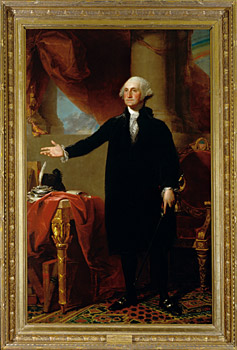 With pencil sketches and watercolor washes, Dan Brown does an excellent job of capturing the life and times of Dolley Madison – beginning when her husband was Secretary of State under Thomas Jefferson and continuing through his own Presidency.
With pencil sketches and watercolor washes, Dan Brown does an excellent job of capturing the life and times of Dolley Madison – beginning when her husband was Secretary of State under Thomas Jefferson and continuing through his own Presidency.
The particular incident related here is historically accurate and significant. When the British marched on Washington DC in 1814, Dolley had to flee and the British burned both the capitol and the President’s residence. The charred sandstone walls of the house survived, and when the interior was rebuilt, Dolley had the exterior white-washed to cover up the smoke and soot stains on the stones. Hence, the “White” house.
 We should all be grateful to Dolley as well for saving George Washington. In the President’s residence (remember, it wasn’t the White House yet), was a life-size portrait of George Washington which had been painted by Gilbert Stuart (see picture at left). Although the soldiers guarding the President’s residence had fled, Dolley refused to leave until the portrait was taken down and removed from the residence to a place of safety. Thanks to Dolley, the painting survived.
We should all be grateful to Dolley as well for saving George Washington. In the President’s residence (remember, it wasn’t the White House yet), was a life-size portrait of George Washington which had been painted by Gilbert Stuart (see picture at left). Although the soldiers guarding the President’s residence had fled, Dolley refused to leave until the portrait was taken down and removed from the residence to a place of safety. Thanks to Dolley, the painting survived.
This little picture book tells the story on about a 3rd-4th grade reading level in 32 pages, hardback, $16.00.
-Rob Shearer
Director, Schaeffer Study Center
Publisher, Greenleaf Press
 Publisher’s Description: “Twelve-year-old Samuel Collier is a lowly commoner on the streets of London. So when he becomes the page of Captain John Smith and boards the Susan Constant, bound for the New World, he can’t believe his good fortune. He’s heard that gold washes ashore with every tide. But beginning with the stormy journey and his first contact with the native people, he realizes that the New World is nothing like he imagined. The lush Virginia shore where they establish the colony of James Town is both beautiful and forbidding, and it’s hard to know who’s a friend or foe. As he learns the language of the Algonquian Indians and observes Captain Smith’s wise diplomacy, Samuel begins to see that he can be whomever he wants to be in this new land.”
Publisher’s Description: “Twelve-year-old Samuel Collier is a lowly commoner on the streets of London. So when he becomes the page of Captain John Smith and boards the Susan Constant, bound for the New World, he can’t believe his good fortune. He’s heard that gold washes ashore with every tide. But beginning with the stormy journey and his first contact with the native people, he realizes that the New World is nothing like he imagined. The lush Virginia shore where they establish the colony of James Town is both beautiful and forbidding, and it’s hard to know who’s a friend or foe. As he learns the language of the Algonquian Indians and observes Captain Smith’s wise diplomacy, Samuel begins to see that he can be whomever he wants to be in this new land.”






